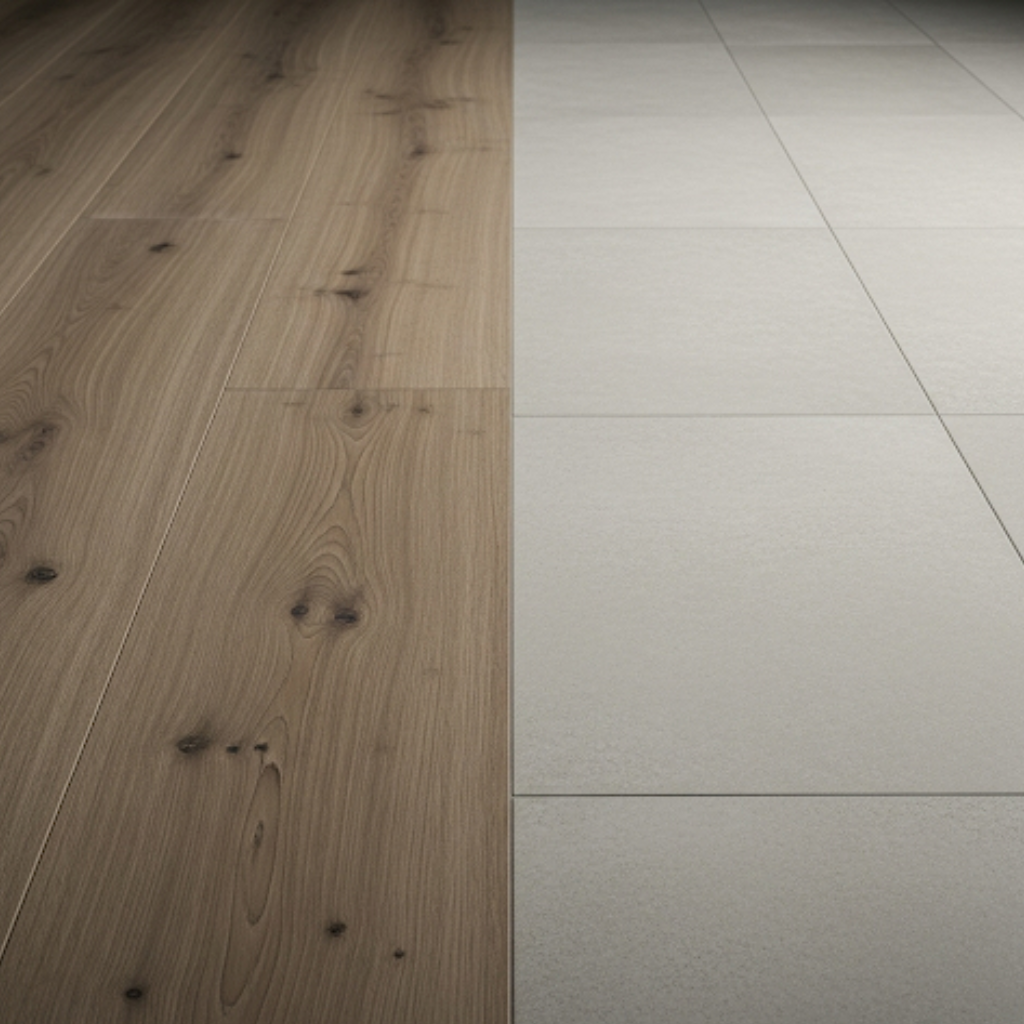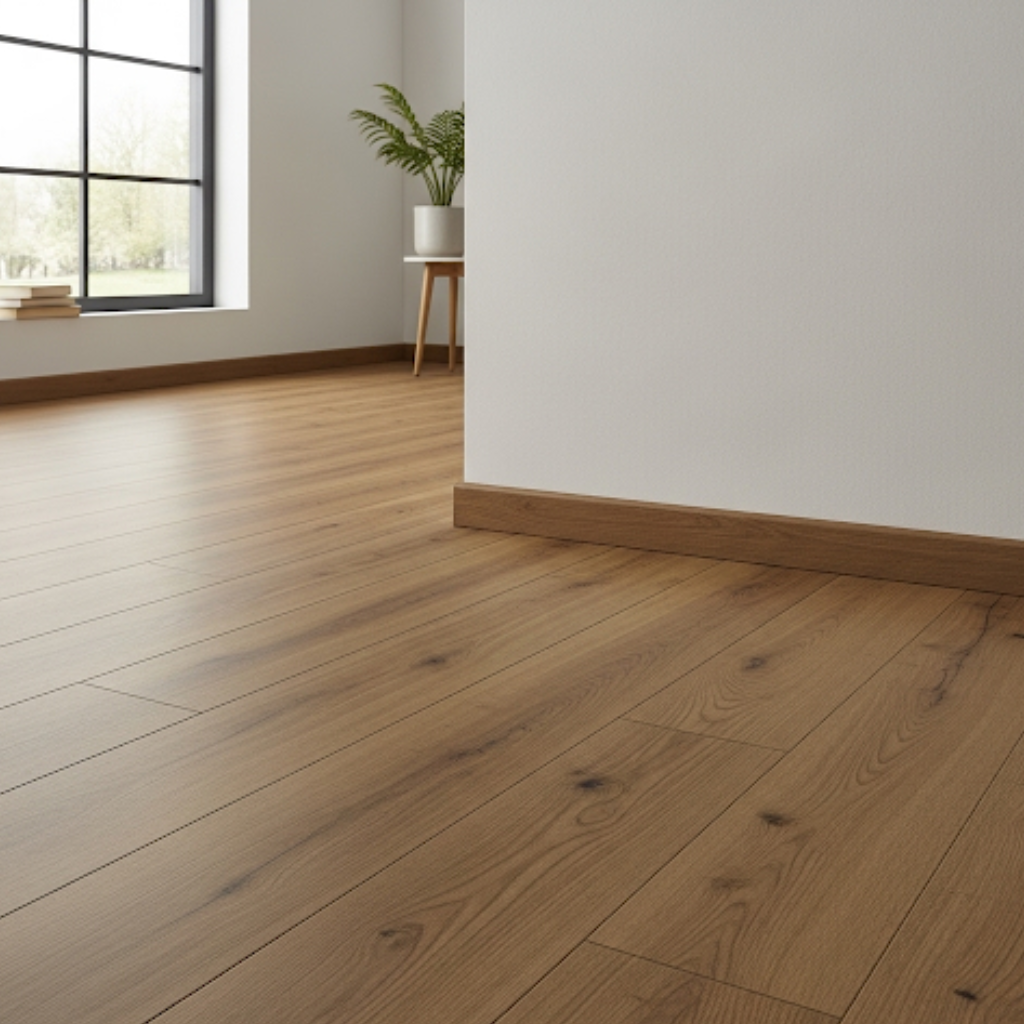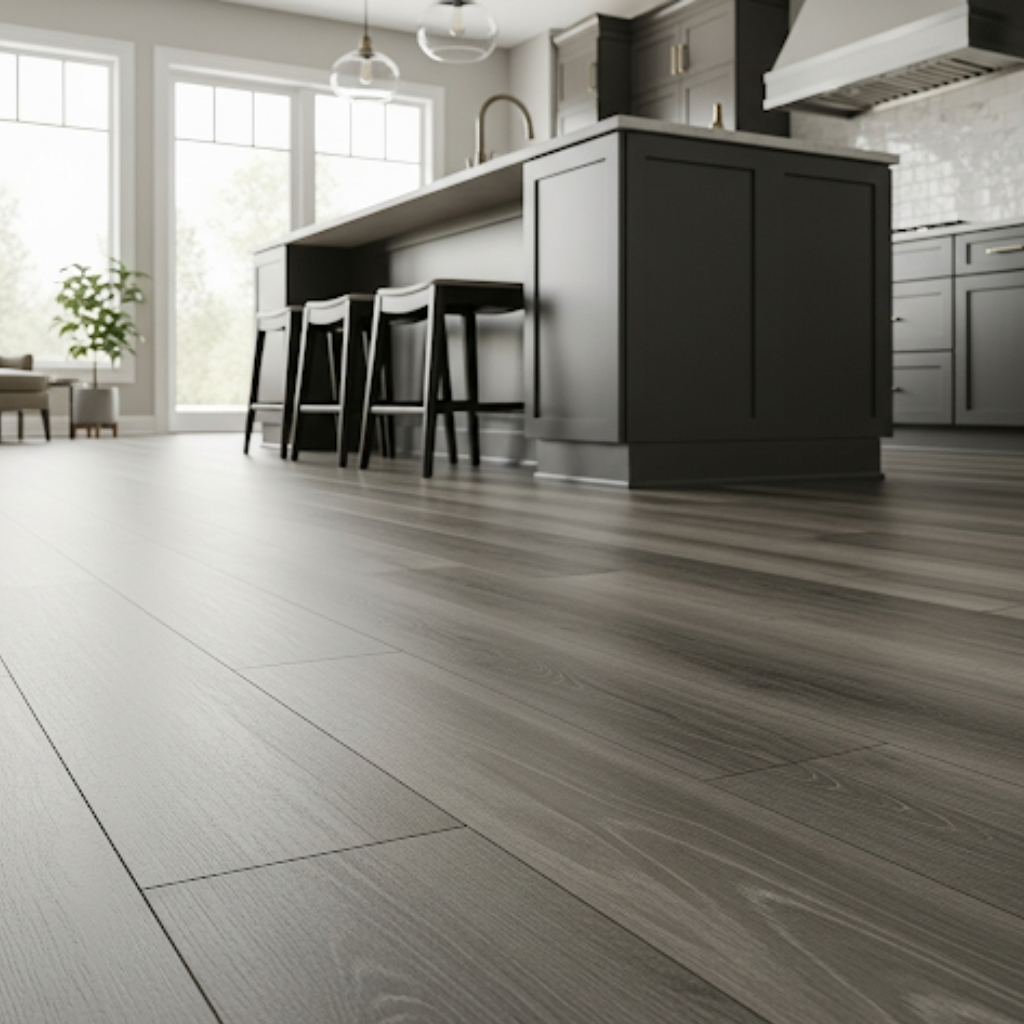Comparing LVT and laminate, LVT flooring offers superior durability and water resistance, making it ideal for areas like kitchens and bathrooms. While LVT has a higher initial cost, its long-term resilience and minimal maintenance can be more cost-effective. Laminate is budget-friendly and mimics traditional materials, perfect if cost is a priority. Installation of both is straightforward, though LVT might need professional assistance. Consider lifestyle needs for the right choice, and discover more insights ahead.
When you're choosing flooring, understanding the fundamental differences between LVT and laminate is essential.
LVT Flooring, or Luxury Vinyl Tile, offers a realistic look of natural materials with durability and moisture resistance.
In contrast, laminate flooring is known for its affordability and ease of installation, but it's not as moisture-resistant as LVT.
LVT flooring, short for Luxury Vinyl Tile, offers an innovative and versatile option for homeowners seeking both style and durability.
You can explore various types of LVT flooring that suit different rooms, lifestyles, and design preferences. It’s a flooring type that’s not just functional but also a statement piece for your living spaces.
You'll appreciate LVT for its:
Embrace the luxury and practicality of vinyl with LVT flooring.
Laminate flooring offers a cost-effective and attractive alternative to traditional hardwood flooring, capturing the essence of natural materials without the hefty price tag.
Suppose you're looking to create a warm and inviting space, whereas laminate floors might be your go-to choice. They bring the charm of wood into your home, fostering a sense of belonging among family and friends.
This type of flooring is made from layers, with the core consisting of high-density fibreboard composed of recycled wood pulp, which makes laminate both eco-friendly and budget-conscious.
Laminate is typically durable, easy to install, and compatible with underfloor heating, making it a practical choice for modern homes.
Its design options are vast, allowing you to express your unique style while enjoying the benefits of an eco-friendly and budget-conscious flooring solution.
Though both LVT flooring and laminate are popular for their affordability and aesthetic appeal, they differ significantly in composition and functionality.
Understanding these differences can help you choose the right flooring for your home and feel confident in your decision.
Choosing between LVT vs laminate means considering your lifestyle and personal preferences.

When considering durability, you'll find that LVT flooring tends to be more resilient against scratches and moisture compared to laminate.
However, laminate can be pretty robust in high-traffic areas if properly maintained.
Both options have distinct maintenance needs, so understanding these can help you decide which is better suited for your lifestyle.
How well can LVT flooring stand up to the demands of daily life?
Luxury vinyl flooring is a durable flooring solution you can count on. Whether you choose luxury vinyl plank or glue-down LVT, it withstands life's challenges, keeping your home looking its best.
Here's why it's a great choice:
Choose LVT for a home that welcomes life's joys.
While laminate flooring offers an attractive and budget-friendly option, its durability depends on various factors.
Laminate is generally durable thanks to its construction from pieces of recycled wood pulp, which are pressed together to form a sturdy core. This makes it a strong contender among flooring choices when considering budget and style.
However, it's important to remember that laminate flooring and LVT have distinct characteristics. Laminate can be susceptible to moisture damage, especially in areas with high humidity. Its surface can also show wear over time, particularly in high-traffic areas.
Despite these considerations, many people find that laminate flooring provides a sense of community and belonging with its warm, wood-like appearance while still being kind to your wallet.
Both LVT and laminate flooring have their maintenance requirements, and understanding these can help you make the right choice for your home.
With an LVT floor, you'll benefit from its waterproof nature, making it easy to mop spills without worry. Vinyl flooring offers a sense of security, knowing it withstands daily life's messes.
Let's explore the maintenance needs:
Choosing the right floor means you're part of a community of savvy homeowners who value simplicity and longevity.
When considering water resistance, you'll find that LVT flooring offers a fully waterproof solution, making it ideal for areas prone to moisture.
Laminate flooring, on the other hand, is water-resistant but not entirely waterproof, which means it's best suited for dry areas.
If you're exploring flooring options for direct sunlight, LVT also performs exceptionally well thanks to its resistance to UV exposure and temperature fluctuations. This makes it a reliable choice not only for wet areas like kitchens and bathrooms but also for bright, sunlit rooms where fading and warping are concerns.
As for installation, both LVT and laminate have straightforward processes, but each has unique requirements and tools.
Unlike some flooring options, LVT flooring offers impressive water resistance, making it a top choice for areas prone to moisture, like bathrooms and kitchens.
LVT flooring is made to handle spills and splashes because it's fully waterproof, like LVT. The differences between luxury vinyl and other flooring types, like laminate vs LVT, highlight why LVT can be installed in moisture-rich environments.
Here's why you'll love LVT's waterproof features:
Embrace LVT for a worry-free, stylish home.
While laminate flooring offers some level of water resistance, it's not entirely waterproof like LVT. You might appreciate that laminate flooring can handle the occasional spill, but it's important to remember that prolonged exposure to moisture might cause damage.
Laminate is made from a combination of wood byproducts and resin, which means it's more vulnerable to water than LVT. This might be a deciding factor if you're considering flooring products for areas prone to moisture, like the kitchen.
When comparing laminate and LVT, think about your lifestyle and how much water exposure your floor might face. If you're part of a community that values practicality and style, understanding these differences can help you choose the right flooring that suits your needs. For example, if you're drawn to the look of natural materials like wood but need something more durable for wet environments, LVT may be the better option.

If you're choosing between LVT and laminate flooring, understanding the installation process is crucial. Both options offer a sense of accomplishment and belonging when you transform your space.
Here's what you need to know:
When considering comfort underfoot, you'll find that LVT often feels softer and warmer compared to laminate.
Luxury vinyl flooring also offers a wide range of aesthetic options, mimicking the look of wood or stone with impressive realism.
As you weigh your choices, think about how both comfort and style fit into your home's overall design.
Although choosing between LVT and laminate can seem daunting, understanding their differences in underfoot comfort can simplify your decision.
When considering flooring for your home, you want a space that feels warm and inviting. Let's explore how each option, whether laminate or LVT, can provide that cosy touch:
Choosing between laminate and LVT flooring impacts how welcoming your home feels.
While both LVT and laminate flooring offer unique aesthetic appeal, LVT often stands out with its impressive versatility and realistic designs.
Imagine walking into a room and feeling like you belong, surrounded by luxury. LVT captures the essence of natural materials, whether you prefer the warmth of wood flooring or the elegance of stone.
Its ability to mimic these materials with stunning accuracy means you can achieve the perfect floor without compromise. Whether you're drawn to the sleek look of tile or the timeless charm of plank styles, LVT provides options that fit any taste.
It invites you to express your style and create a space that feels like home, enhancing the aesthetic appeal of your interiors effortlessly, all while being crafted from materials such as recycled wood pulp pressed into durable layers.
Deciding between LVT and laminate flooring for your home hinges on factors like comfort and aesthetics.
You want a space that feels inviting and reflects your style. So, how do you choose between LVT and laminate? Here are some key differences:
Choosing between LVT and laminate depends on what's best for your home's unique needs, ultimately creating a welcoming haven for everyone.
When you're comparing costs, LVT flooring often has a higher upfront price compared to laminate.
However, consider whether the long-term value of luxury vinyl tile flooring might outweigh initial expenses, especially if durability is a priority.
As you plan your flooring installation, assessing your budget and future needs will guide your decision.
Choosing between LVT flooring and laminate often boils down to cost considerations. You want a home that reflects your style without breaking the bank.
LVT and laminate flooring are both popular options, but there are key price differences to consider. Generally, LVT is more expensive than laminate. Here's why:
Considering LVT and laminate, weigh these factors to find the right fit for your home.
Considering the price differences between LVT and laminate, it's clear that LVT comes with a higher upfront cost.
However, when assessing the long-term value, LVT often proves its worth. LVT is made from multiple layers, offering durability and resistance to moisture, which makes it a great type of flooring for areas prone to spills.
The difference between LVT and laminate lies in their construction and resilience. While vinyl and laminate may seem similar to laminate, LVT's robust build ensures it withstands wear over time, adding to its longevity.
When you invest in LVT, you're choosing a flooring solution that not only enhances your home's aesthetic but also provides lasting value, fostering a sense of belonging and comfort in your living space.

Embarking on a flooring installation requires a clear understanding of your budget. You want to create a space that feels like home without breaking the bank.
When budgeting for your flooring installation, consider the following:
Material Costs: LVT tends to be more affordable than traditional real wood or stone options. It's a great choice if you're looking for elegance without the hefty price tag.
Eco-Friendly Options: Laminate flooring, often made from recycled wood pulp and tiny pieces of recycled wood, offers a sustainable choice for environmentally conscious homeowners.
Durability: Consider long-term costs. LVT and laminate both provide durability, but your lifestyle might sway your decision.
Installation Fees: Factor in installation costs. DIY can save money, but professional help ensures a flawless finish.
Together, we can make your flooring dreams come true!
When choosing between LVT and laminate flooring, consider your priorities. If durability and water resistance are top concerns, LVT might be the best for your home. It handles moisture well and is easy to maintain. However, if budget and aesthetics are more critical, laminate offers a wide range of styles at a lower cost, making it a popular flooring choice for many.
Ultimately, both options have their strengths, so weigh your needs and preferences to decide which flooring suits your home best.